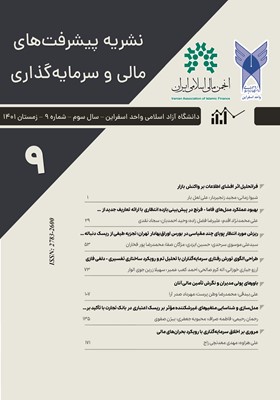Designing the behavioral bias pattern of investors with theme analysis and fuzzy interpretive-Delphi structural approach
Subject Areas : InvestmentsArezo Jabari Khouzani 1 , Allah Karam Salehi 2 * , Ahmad, Kaab Omeir 3 , Soheila Zarinjooy Alvar 4
1 - Department of Accounting, Ahvaz Branch, Islamic Azad University, Ahvaz, Iran.
2 - Department of Accounting, Masjed-Soleiman Branch, Islamic Azad University, Masjed-Soleiman, Iran.
3 - Department of Accounting, Ahvaz Branch, Islamic Azad University, Ahvaz, Iran.
4 - Department of Business Management, Abadan Branch, Islamic Azad University, Abadan, Iran.
Keywords: fuzzy Delphi, Theme Analysis, Behavioral Biases, Interpretive Structural Approach,
Abstract :
Purpose: The purpose of the current research is to design the behavioral bias pattern of investors with theme analysis and fuzzy interpretative-Delphi structural approach.Methodology: This research is one of the mixed researches with qualitative and quantitative approach that was carried out in the period of 2020-2021. The statistical population of the research consists of managers and experts in the field of capital market and academic experts, and 16 of them were selected as sample members using the principle of theoretical adequacy and the snowball sampling method. In the qualitative part of the research, the method of theme analysis was used to identify the influencing factors on behavioral bias and to collect data, a semi-structured (in-depth) interview was used. Also, in the quantitative section, a questionnaire was used to collect information, and interpretive structural analysis and MICMAC analysis were used to determine the most effective components.Findings: The findings in the qualitative part using thematic analysis showed that the factors affecting the behavior biases of investors in Iran is consist of personality traits, perceptual and behavioral traps, customer journey map, emergence of collective mind, revelatory behavior theory, perspective theory, market theory and cognitive alignment.Originality / Value: The results of the research include the identification and prioritization of the most important factors influencing the behavior of investors, and finally, 8 main components and 33 determining themes were identified according to experts, which can be used to clarify the investors decisions, better analyze and improve the capital market efficiency.
Ritter, J. R. (2003). Behavioral finance. Pacific-Basin Finance Journal, 11(4), 429–437.
Wilde, G. J. S. (1998). Risk homeostasis theory: an overview. Injury Prevention, 4(2), 89–91.
_||_

